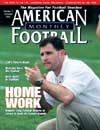AMERICAN FOOTBALL MONTHLY THE #1 RESOURCE FOR FOOTBALL COACHES
Article CategoriesAFM Magazine
|
Efficiency in the Scoring Zoneby: Brian RockOffensive Coordinator, Western Michigan © More from this issue From the time we watched our first game, we all understood the fundamental role of the offense in the game of football. The purpose of the offense is not to control the clock, nor is it to create field position or give the defense a rest. Although these are all important by-products of an effective offense, they are not the primary focus. The role of the offense is to score points, period. It is with that basic premise in mind that we communicate and develop our philosophy for the area between the opponents' 25-yard line and their 5-yard line, the area we refer to as the "Scoring Zone". We use this reference in an effort to communicate to our team what we intend to do when the ball reaches this point.
Goals When developing a scoring zone philosophy or plan, we must first set parameters or goals of what we are tryin....The full article can only be seen by subscribers.
|
|
|||||||
| HOME |
MAGAZINE |
SUBSCRIBE | ONLINE COLUMNISTS | COACHING VIDEOS |
Copyright 2025, AmericanFootballMonthly.com
All Rights Reserved





